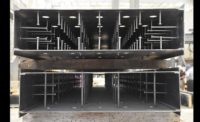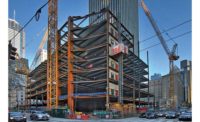Score another small victory for more-constructible high-rises, especially in seismic zones. Results of recent load tests on a "sandwich" shear-wall assembly, designed to simplify and speed construction of core shear walls surrounded by steel frames, are equal to or better than anticipated, say researchers.
The sandwich, called a dual-plate composite shear wall because its steel- plate walls are filled with lightly reinforced concrete, is not for use only in seismic zones. "It is a great system for multihazard mitigation because it is good for seismic, wind and gravity loads as well as blast resistance," says Ron Klemencic, president of Seattle-based structural firm Magnusson Klemencic Associates (MKA).
"There shouldn't be any kind of a height limit for the system's use," adds Klemencic, who is on the board of the Charles Pankow Foundation, which sponsored the $338,193 research. "It may prove even more valuable to a taller building," he adds.
The sandwich is intended as a replacement for a concrete shear-wall core, common to steel-framed office towers. A 50-story tower with the sandwich core could take two to three months less time to build, overall, than a tower with a concrete core, says Klemencic, who is also the Pankow industry representative for the research team, based at Purdue University, West Lafayette, Ind. MKA and steel fabricator Canron/The Supreme Group provided in-kind support to the project.
Concrete cores take longer because the walls are typically constructed on a three-day cycle using climbing forms. The pace of construction is often slowed by the time it takes to reset the forms from floor to floor. In the sandwich system, the permanent plates replace the formwork, eliminating a step.
The sandwich is a generic version of a Tata Steel product, called Bi-Steel, from the U.K. The 27-ft-tall specimen, a "T" in plan, consisted of a 6-ft-deep web member and a 7.5-ft-deep flange member anchored in a concrete-block foundation.
Steel plates, 3/16 in. thick, sandwiched 8 5/8 in. of concrete. Steel rods, spaced 4.5 in. apart, connected the plates. The specimen was representative of a core wall at about 3/8 scale, says Michael Kreger, co-principal investigator of the research, with Mark Bowman. Both are Purdue professors of civil engineering.
The team tested the plate assembly's stiffness, without concrete, to investigate plate thickness and the size and spacing of connection rods and their attachments. Tests also were conducted on the buckling capacity of the assembly, without concrete, to determine safe construction loads. Those showed the steel frame could advance four floors ahead of concrete.
Composite Action and Compatibility
Other items researched included composite action and compatibility of the steel-concrete assembly; shear capacity of the horizontal splice between vertically stacked plates; welds at the base connection—plate to plate and between rebar and the plate; wall-to-wall vertical connections and panel-to-panel horizontal connections, and connections at the base.
Tests were conducted over five years at Purdue's Bowen Laboratory for Large-Scale Civil Engineering Research. The high-bay section of the lab consists of a 40-ft-tall concrete strong wall and a strong floor. Hydraulic equipment pushes and pulls the specimen against the strong wall, imposing a maximum of 230 tons of load.
In a final test on Feb. 3, the assembly was pushed to 2% total drift with no significant deterioration. "This was a proof test of those [connections]," says Kreger.
Later this year, the team plans to publish documentation to enable engineers to design connections necessary to make this system work, using performance-based design. Klemencic already is seeking a real project "to implement" the system.





Post a comment to this article
Report Abusive Comment